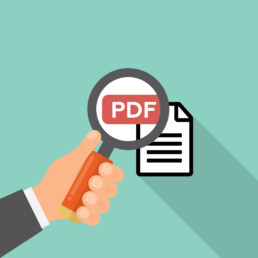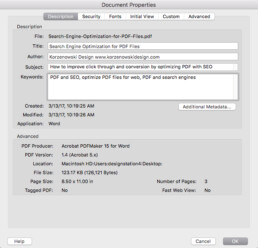
Optimizing PDF files for search engines
By now, you’ve probably heard all about search engine optimization (SEO) and how it affects your visibility on the internet.
Essentially, the strategy of SEO comprises a set of best practices and techniques that maximize your content’s potential for being found in an organic search result. It is the process of making your information as appealing as possible to both search engines and web users alike. You can apply SEO thinking to everything from headlines, copy, images and even downloadable PDFs on your site to improve click-through rates and conversions.
What is a PDF?
PDF stands for “portable document format.” The PDF format was created to maintain document layout structure as the files travel through and are interpreted by different operating systems and computers. Basically, PDF files function as a near universal means of consistent electronic communication; almost everyone has a PDF reader on their device.
Companies will post PDFs to their websites to maintain the visual layout for catalogs, instruction manuals, white papers and even Power Point presentations. Uploading a PDF is less expensive than recreating the layout in HTML, and the PDF format will ensure the file will print on a desktop printer exactly as it is shown on screen.
[Pro Tip]: When creating or repurposing a file as a downloadable PDF, it’s a good idea to include navigation and related links to other areas of your website to keep the interaction going.
Search engines will generally crawl and index your PDFs like any other page of your website, so you should take advantage of all the SEO opportunities.
SEO for PDF
Search engines will automatically pull information from your content to create a “snippet” that will post on the search engine results page (SERP). Not only does optimizing your PDF files help search engines better understand what your content is about, it also allows you to create a more compelling snippet for the humans searching for your content.
PDFs that appear in a search result will look similar to a web page result, but there will be a small [PDF] included, like this:
1.) Creating a PDF
You can create a PDF using several sources, including Word, PowerPoint, InDesign and Photoshop. However, if you’re creating the PDF as a corporate communiqué, it is very important that the design is on brand, on message and coordinates with existing marketing efforts.
2.) Naming your PDF file
Your PDF file name will appear on the SERP as part of the target URL. Be sure to include your best keywords and separate words with hyphens or underscores underscores (e.g. Search-Engine-Optimization-for-PDF-Files.pdf).
3.) Adding descriptive metadata
After you’ve created your PDF, open it and select File>Properties from the pull-down menu. This will open the Document Properties window. The first tab is your file Description, which will help describe your content to search engines and provide the information presented on the SERP.
File: This section will be automatically filled with the file name assigned when the PDF was created.
Title: Include your best keywords here, as well. This is what will show most prominently on the snippet created by the search engine. The title is what should entice people to click through to your content. Keep it under 50 characters.
Author: This section can include your name, your company name and/or your website URL.
Subject: Use this section to create a brief summary of what your content is all about. Search engines will generally use this section for the meta description on the SERP. Again, this should be an enticement for a searcher to click through to your content.
Keywords: Add descriptive words and phrases that directly relate to your content and could be used in a search query. Try to be as focused as possible, limit yourself to three or four words or phrases and separate them with commas or semicolons.
You can click on the “Additional Metadata…” button for a lot of other data fields, including copyright and contact information, but completing this section is sufficient for SEO best practices and creating a clean layout of relevant, enticing information on the SERP.
